Table 3.
AKIs in preclinical studies
| Compound names |
Structures | Targets (IC50) |
Cell-based potency (IC50/EC50/GI50) |
Animal models (type; concentration; efficiency) |
Ref |
|---|---|---|---|---|---|
| CYC3 |

|
AURKA (0.033 μM)) |
IC50: MIA PaCa-2 (1.1 μM) PANC-1 (2 μM) |
NA | [79] |
| AKI603 |

|
AURKA (12.3 nM) | NA | Epirubicin resistant MCF-7 cell xenograft; mice were treated intra-gastrically every day with 50 mg/kg AKI603; tumor volume and tumor weight were significantly reduced. | [80] |
| BPR1K0609S1(BP) |

|
AURKA (43 nM) | HCT116 (400 nM) | Parental and BP-resistant HCT116 Puma(−), Bax(−), Chk2(−) and p53(−) cells were transplanted into nude mice; these BP-resistant cells did not show faster tumor development compared to their parental cells, respectively. | [81, 82] |
| LDD970 |

|
AURKA (0.37 μM) |
IC50: HT29 (4.22 μM) |
NA | [83] |
| MK-8745 |  |
AURKA (0.6 nM) | NA | HCT116, HCT116 p53(−), HCT116 Puma(−), HCT116 p21(−) and HCT116 Chk2(−) xenografts; MK-8745 (800 nM) was directly s.c. injected daily; HCT116 p53(−) tumorigenesis was weakly inhibited, HCT116 Puma(−), HCT116 p21(−), HCT116 Bax(−) and HCT116 Chk2(−) cells was inhibited with MK-8745. | [84, 85] |
| LY3295668 |

|
AURKA (< 1 nM) | 55 out of 80 cell lines displayed sensitivity (IC50 < 1 μM) to LY3295668 with an average IC50 of 0.048 μM |
1. NCI-H446 xenograft model; 50 mg/kg (s.c), (BIDX7, rest 14) X 2, (BIDX14, rest 7) X 2, or (BIDx21) X 2 schedule; produced significant tumor growth inhibition. 2. PDX; 50 mg/kg BIDX28 showed 97.2% of tumor growth inhibition. |
[86] |
| BPR1K653 |

|
AURKA (124 nM) AURKB (45 nM) |
IC50: A549 (9 nM) HT29 (12 nM) OECM-1 (135 nM) HONE-1 (11 nM) KB (12 nM) NTUB1 (8 nM) MV4–11(5 nM) IM9 (4 nM) |
Cervical cancer KB xenograft; 15 mg/kg through intravenous injection for two weeks; 73% decrease in tumor volume. |
[87] |
| TY-011 |

|
AURKA (102.1 nM) AURKB (93.9 nM) |
IC50: SNU-16 (0.09 μM) MKN-45 (0.13 μM) MGC-803 (0.19 μM) SGC-7901(0.57 μM) AGS (0.96 μM) |
Gastric cancer cell MGC-803 xenograft; TY-011 was orally administered at 3, 6 and 9 mg/kg once a day for 13 days; 64.9, 87.7, 89% inhibition rate for 3, 6 and 9 mg/kg respectively. | [88] |
| BPR1K871 |
|
AURKA (22 nM) AURKB (13 nM) FLT3 (19 nM) |
EC50 values ranged from 34 nM to 7 μM in various cancer cells. COLO205 (34 nM) Mia-PaCa2 (94 nM) |
Colorectal COLO205 or pancreatic Mia-PaCa2 xenograft; 15 mg/kg intravenous administration of BPR1K871 once a day for two continuous weeks (on days 1–5 and 8–12); TGI was about 90%. | [89] |
| SCH-1473759 |

|
AURKA (≤4 nM) AURKB (≤ 13 nM) |
In 51/53 tumor cells IC50 < 100 nM. The mean IC50 was 21 nM. A2780, LNCap, N87, Molt4, K562, and CCRF-CEM with IC50 < 5 nM. | A2780 human tumor xenograft; 5 mg/kg (i.p) bid dosed daily on days 0–16 (TGI = 50%) and 10 mg/kg (i.p) bid dosed intermittently on days 0–4 and 10–14 (TGI = 69%). | [90] |
| Derrone |

|
AURKA (22.3 μM) AURKB (6 μM) |
H1299 (23.8 μM) MCF7 (24.4 μM) Hela (31.2 μM) KPL4 (45.8 μM) |
NA | [91] |
| JNJ-7706621 |
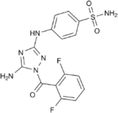
|
AURKA (11 nM) AURKB (15 nM) CDK1 (9 nM) CDK2 (4 nM) |
IC50 values ranged from 112 to 514 nM in various cancer cell lines while IC50 values ranged from 3.67 to 5.42 μM in normal cells. | A375 xenograft model; JNJ-7706621 was treated i.p using 125 mg/kg 7 on/7 off schedule and the 100 mg/kg QD schedule; TGI values were 93% for both two schedules. | [92] |
| SAR156497 |

|
AURKA (0.6 nM) AURKB (1 nM) AURKC (3 nM) |
SAR156497 was active on various tumor cell lines (IC50: 5–500 nM). | HCT116 xenografts; compound was s.c injected in continuous infusion using ALZET micropump at an 8 μL/h flow rate for 48 h and at doses of 25 mg/kg; TGI% = 81%. Note: therapeutic window was narrow. | [93] |
| R1498 |

|
VEGFR2 (25 nM) AURKA (67 nM) AURKB (167 nM) |
Mean IC50s were 7.81, 7.55 and 30.07 μM in epatocellular carcinoma, gastric cancer, and nasopharyngeal carcinoma cell lines, respectively. |
1. BEL-7402, MGC-803 and SGC-7901 xenografts; 25 mg/kg, twice daily, orally; R1498 showed better TGI% over sorafenib. 2. CNE-2 xenograft; 25 mg/kg, twice-daily, oral gavage; TGI% was 90%. 3. Three PDX model; TGI% reached 73.6–91.6% (25 mg/kg, twice-daily, oral gavage). |
[94] |
| VE-465 |

|
AURKA (1 nM) AURKB (26 nM) AURKC (8.7 nM) |
Huh-7 (2.01 μM) HepG2 (4.15 μM) |
HCC human Huh-7 xenograft; twice a day i.p with VE-465 at 15, 25, and 35 mg/kg for 14 days; the mean tumor volumes were reduced by 59, 59, and 77%, respectively. | [95] |
| CCT129202 |
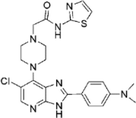
|
AURKA (0.042 μM) AURKB (0.198 μM) AURKC (0.227 μM) |
GI50: Colo205 (0.46 μM) SW620 (0.7 μM) HCT116 (0.35 μM) HT29 (0.5 μM) KW12 (1.2 μM) Hela (0.2 μM) A2780 (0.3 μM) OVCAR8 (1 μM) MV4–11 (0.08 μM) |
HCT116 colon carcinoma xenografts; mice were treated i.p. with a single dose of 100 mg/kg /day for 9 days; Significant tumor growth inhibition was observed compared with the vehicle-treated mice (% treated versus control, 57.7; P = 0.0355) |
[96] |
| CCT137690 |
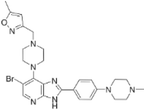
|
AURKA (0.015 μM) AURKB (0.025 μM) AURKC (0.019 μM) FLT3 (0.0025 μM) |
CCT137690 effectively inhibited the growth of human tumor cell lines of different origins with GI50 values ranging from 0.005 to 0.47 Μm. |
1. SW620 xenografts; orally at a dose of 75 mg/kg twice a day for 21 days; The treated/control (T/C) ratio was calculated as 42.4% based on final tumor weight. 2. MYCN-driven transgenic mouse model; 100 mg/kg twice daily for 10 days; TGI was observed as early as day 3 and continuous treatment showed significant tumor growth inhibition at day 7 and day 10. |
[97, 98] |
| PHA-680632 |

|
AURKA (27 nM) AURKB (135 nM) AURKC (120 nM) |
PHA-680632 has potent antiproliferative activity in a wide range of cell types with an IC50 in the range of 0.06 to 7.15 μM. |
1. HL60 xenograft; mice were injected i.v. at three dose levels (15, 30, and 45 mg/kg for 5 days); the 45 mg/kg dose resulted in 85% of TGI without signs of toxicity. 2. A2780 xenograft; 60 mg/kg i.v. for 5 days; TGI% = 78%. 3. HCT116 colon carcinoma xenograft; 15 and 30 mg/kg i.p for 12 days; TGI was 75%. |
[99] |
| AKI-001 |
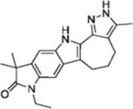
|
AURKA (0.004 μM) AURKB (0.005 μM) |
HCT116 (0.07 μM) HT29 (0.07 μM) MCF7 (0.1 μM) |
HCT-116 xenograft model; Mice were dosed orally QD for 21 days (0, 1, 2.5, 5, or 10 mg/kg); 2.5 (82% TGI) and 5 mg/kg (92% TGI). Note: dosing at 10 mg/kg QD led to unacceptable weight loss, marked bone marrow depletion, and gastrointestinal hypocellularity. |
[100] |
| Reversine |
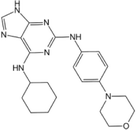
|
AURKA (400 nM) AURKB (500 nM) AURKC (400 nM) |
IC50 values ranged from 100 to 1000 nM of a wide variety of tumor cell lines. | U14 cell xenograft; mice were treated with reversine (10 mg/kg) alone or with aspirin (1 μg/kg), i.p per 3 days; tumor growth was reduced and the mice survived longer in the combination group. | [101] |
Tumor growth inhibition (TGI); Intraperitoneal injection (i.p); Subcutaneous (s.c); Intravenous (i.v); Growth inhibition by 50% (GI50); Twice a day (BID); Once a day (QD); NA: not available
